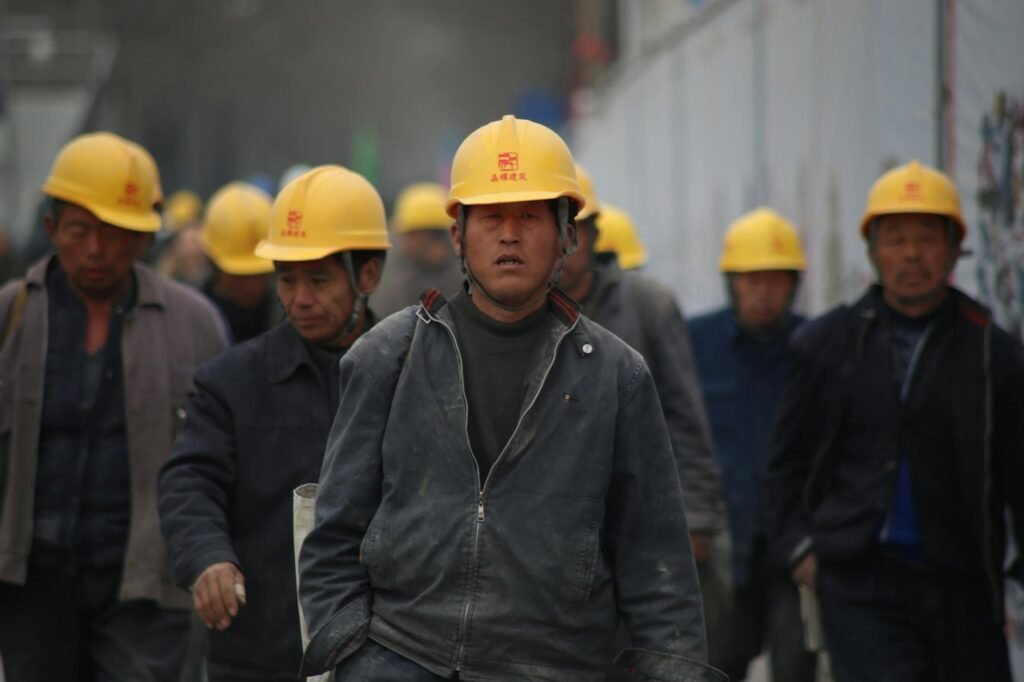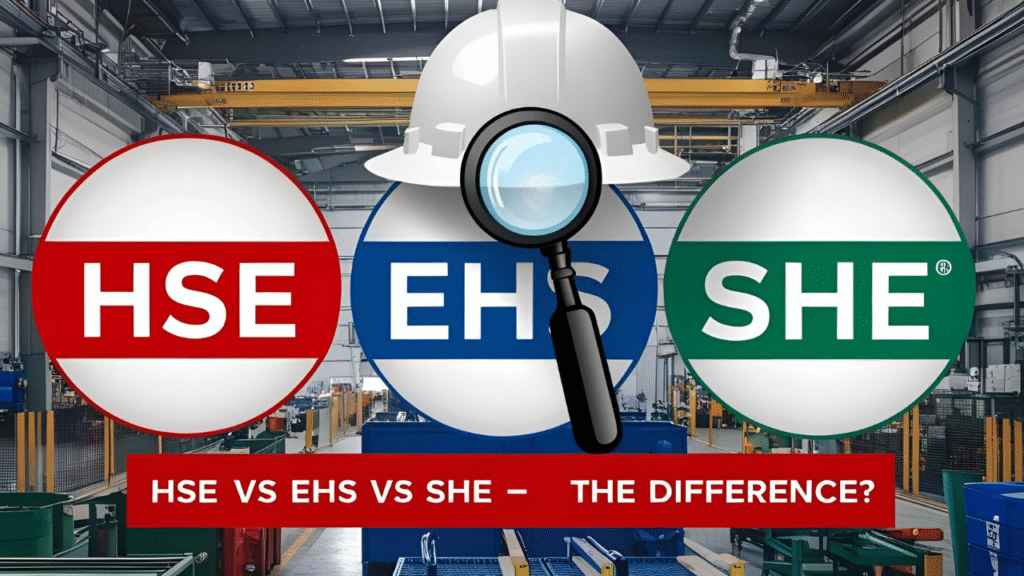
HSE vs EHS vs SHE: Difference Between HSE, EHS, and SHE – A Detailed Comparison
1. Introduction
In occupational safety and environmental management, the terms HSE (Health, Safety, and Environment), EHS (Environment, Health, and Safety), and SHE (Safety, Health, and Environment) are often used interchangeably. However, subtle differences exist in their focus, industry applications, and regulatory implications.
This article explores:
- Definitions of HSE, EHS, and SHE
- Key differences in priorities and applications
- Industry-specific usage
- Regulatory and organizational influences
- Real-world examples
2. Definitions and Core Concepts
A. HSE (Health, Safety, and Environment)
HSE emphasizes human health and safety first, followed by environmental protection. It is commonly used in oil and gas, construction, and heavy industries where worker safety is a major concern.
Example:
An oil refinery prioritizes preventing worker injuries (Safety), followed by reducing air pollution (Environment).
B. EHS (Environment, Health, and Safety)
EHS places environmental concerns first, followed by health and safety. It is prevalent in chemical, pharmaceutical, and manufacturing industries where environmental compliance is critical.
Example:
A chemical plant focuses on reducing toxic waste (Environment), then ensures worker exposure limits are met (Health & Safety).
C. SHE (Safety, Health, and Environment)
SHE starts with safety as the top priority, followed by health and environment. It is often used in mining, construction, and high-risk industries where immediate physical hazards dominate.
Example:
A mining company prioritizes preventing cave-ins (Safety), then addresses lung diseases (Health) and land degradation (Environment).

3. Key Differences Between HSE, EHS, and SHE
| Aspect | HSE (Health, Safety, Environment) | EHS (Environment, Health, Safety) | SHE (Safety, Health, Environment) |
|---|---|---|---|
| Primary Focus | Worker health & safety first | Environmental compliance first | Workplace safety first |
| Industry Usage | Oil & gas, construction | Pharmaceuticals, chemicals | Mining, heavy manufacturing |
| Regulatory Influence | OSHA, ILO standards | EPA, ISO 14001 | MSHA, OSHA |
| Risk Priority | Human health > Safety > Environment | Environment > Health > Safety | Safety > Health > Environment |
| Example | Preventing gas leaks (Safety) before waste disposal (Environment) | Reducing emissions (Environment) before worker PPE (Health) | Preventing falls (Safety) before dust control (Health) |
4. Why Do These Differences Exist?
A. Industry-Specific Risks
- HSE is common in oil and gas because worker fatalities (e.g., explosions) are a bigger concern than minor environmental spills.
- EHS dominates in pharmaceuticals because chemical waste disposal is heavily regulated (EPA).
- SHE is crucial in mining because immediate physical dangers (collapses, equipment accidents) take precedence.
B. Regulatory Requirements
- EHS is influenced by environmental laws (e.g., U.S. EPA, REACH in EU).
- HSE/SHE are shaped by occupational safety laws (e.g., OSHA, ILO).
C. Corporate Culture & History
- Some companies use SHE due to legacy systems (e.g., British vs. American terminology).
- EHS is more common in U.S. firms due to stricter environmental regulations.
5. Real-World Examples
Example 1: Oil & Gas Industry (HSE Focus)
- Priority: Preventing worker deaths in refinery explosions.
- Measures:
- Regular safety drills (Safety)
- Health checks for toxic exposure (Health)
- Spill containment systems (Environment)
Example 2: Pharmaceutical Company (EHS Focus)
- Priority: Compliance with chemical waste disposal laws.
- Measures:
- Wastewater treatment (Environment)
- Lab ventilation systems (Health)
- Fire safety protocols (Safety)
Example 3: Mining Operation (SHE Focus)
- Priority: Preventing fatal accidents in underground mines.
- Measures:
- Collapse-resistant structures (Safety)
- Dust control for lung protection (Health)
- Land reclamation post-mining (Environment)
6. Which One Should a Company Use?
The choice depends on:
- Industry Risks (e.g., mining = SHE, chemicals = EHS).
- Legal Requirements (EPA-heavy sectors prefer EHS).
- Corporate Policy (Some global firms standardize one term).
Best Practices:
- Manufacturing: EHS (chemical hazards, EPA rules).
- Construction: SHE (immediate physical dangers).
- Oil & Gas: HSE (worker safety is critical).
7. Common Misconceptions
❌ “HSE, EHS, and SHE are the same.”
✅ Reality: The order of priority differs based on industry risks.
❌ “Only large corporations need EHS.”
✅ Reality: Even small businesses must comply with OSHA/EPA rules.
❌ “SHE is outdated.”
✅ Reality: Many industries (mining, construction) still use SHE for safety-first approaches.
8. Conclusion
While HSE, EHS, and SHE share similar goals, their order of priority reflects industry-specific risks:
- HSE = Health & Safety first (Oil & Gas).
- EHS = Environment first (Pharma, Chemicals).
- SHE = Safety first (Mining, Construction).
Companies should choose the framework that aligns with their biggest risks and regulatory demands.
9. FAQs
Q1. What Do HSE, EHS, and SHE Stand For?
- HSE: Health, Safety, and Environment
- EHS: Environment, Health, and Safety
- SHE: Safety, Health, and Environment
While all three acronyms cover the same core elements (Health, Safety, and Environment), the order of the letters indicates a slight difference in priority and emphasis.
Q2. What Is the Main Difference Between HSE, EHS, and SHE?
The key difference lies in which aspect is prioritized:
- HSE (Health, Safety, Environment): Focuses first on employee health and safety, then environmental concerns.
- EHS (Environment, Health, Safety): Prioritizes environmental compliance before health and safety.
- SHE (Safety, Health, Environment): Emphasizes workplace safety as the top priority.
Q3. Which Industries Commonly Use HSE, EHS, and SHE?
- HSE: Common in oil & gas, construction, and heavy industries where worker safety is critical.
- EHS: Used in manufacturing, chemical, and pharmaceutical industries where environmental regulations are strict.
- SHE: Often seen in mining, logistics, and high-risk workplaces where accident prevention is key.
Q4. Are HSE, EHS, and SHE Governed by Different Regulations?
No, they generally follow the same regulations but may align with different standards based on industry needs:
- HSE: OSHA (Occupational Safety and Health Administration), ISO 45001 (Occupational Health & Safety).
- EHS: EPA (Environmental Protection Agency), ISO 14001 (Environmental Management).
- SHE: Combines OSHA and EPA guidelines but with a stronger focus on safety protocols.
Q5. Do HSE, EHS, and SHE Have Different Management Systems?
Yes, their management systems may vary in structure:
- HSE Management System: Focuses on risk assessments, safety training, and incident reporting.
- EHS Management System: Emphasizes waste management, emissions control, and sustainability.
- SHE Management System: Prioritizes hazard identification, emergency response, and PPE compliance.
Final Thoughts
Understanding the differences between HSE, EHS, and SHE helps organizations implement the right safety culture. While the terms are similar, their priorities impact compliance, risk management, and operational efficiency. Companies should choose the model that best aligns with their industry hazards and legal obligations.
Introduction of HSE (Health, Safety, and Environment)
Unsafe Act vs Unsafe Condition: Key Differences with Industry Examples






















